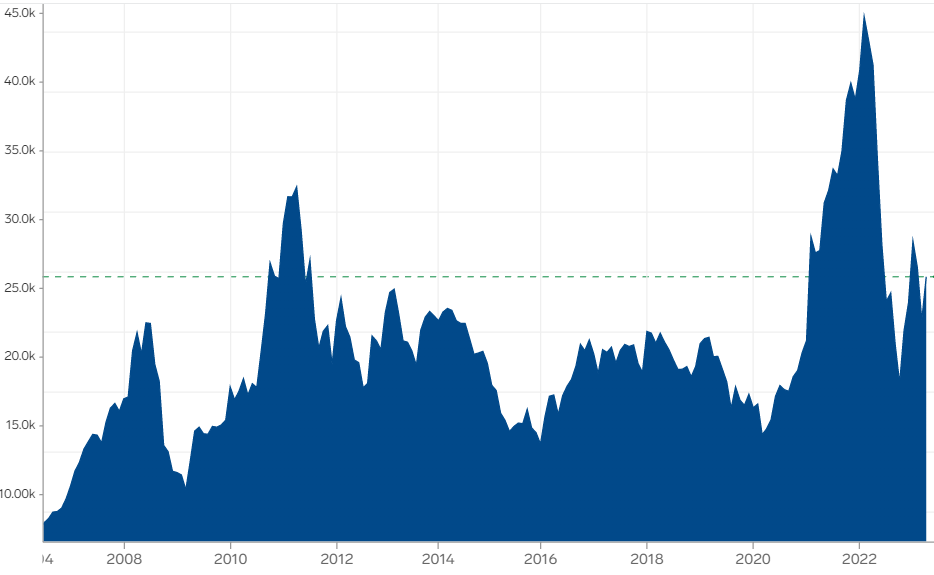Alphamin Resources ($AFMJF)
Tin mine with growth and low operating costs. Interesting investment if you believe tin production supply will fall short in next years
Executive Summary
+ Strong operations
(low-cost tin producer, high grades, one mine up & running, second coming)
+ Strong balance sheet
(no long term debt, a strong controlling shareholder, limited dilution, div distribution)
+ Growth from opening 2nd mine on site in Dec ‘23 (Mpama South), +66% volumes
Further longer term growth can/will come from exploring the region for mining sites
+/- Revenues fluctuate together with Tin price and are unhedged. Medium term tin price is supported by supply loss (China stockpiles should come down now the country is exiting Covid lockdowns, the world largest producer acknowledges declining reserves and the second largest producer in Peru is shut down for maintenance)
- Local gvmt can impose additional taxes, although levels are already at 30% and they own a 5% (Congo) + 10% (South Africa) stake in the company.
Conclusion: See valuation details below. It all boils down to where you think tin prices will move in the future. We see the company at $0,65.share (US listing $AFMJF) fairly valued for a bear case ($20k tin), but there is large operational leverage possible should prices move higher in the next years (Asia tin supply slowing, US + EU tin demand increasing)
Action: limit buy order at $0,55 per share for first position
Analysis
Alphamin owns 84% of the Bisie tin mine in the Democratic Republic of Congo (DRC) which is regarded as the world’s highest-grade tin mine
Currently the focus is on two mine sites (Mpama North & South)
North is up & running, delivering 12k tonnes / year and has 155k tonnes reserve
South is being developed (timing Dec ‘23) costing $116m investment (which AFM self funded - no dilution) and aiming for another 8k tonnes / year and has currently 90k tonnes reserves
Both sites have high grade tin and allow the company to operate at low costs
Further long term exploration in the region is possible
Q1 2023 results
3,187 ton produced, stockpiles are high, average tin grade is above expectations
Production expansion (Mpama South) progressing on timing (Dec ‘23) and budget
Global Tin Market
Demand = today mostly used in chips, hence semiconductor revenues are a proxy for tin usage. Long term trends are AI, advanced robotics, IoT, but also renewable energy and batteries. Biggest tin stocks lie in China. With future ‘nearshoring’ of critical chip production activities, Western companies will need to look for non-Chinese tin production
Supply = 380.000 tonnes / year, not increasing much in recent years
Indonesia is declining, with fears of an export ban (to boost local processing)
Yunnan Tin (China - largest Tin producer worldwide) is citing“accelerate overseas investments due to decreasing tin reserves'“
Production levels expected to require +50.000 tons by 2030 and no other large mines will start by 2027
Note the 2021-2022 tin price surge to $45k was due to chips shortage during Covid lockdowns
Valuation
Say tin prices are stuck at $20k levels (bear case). With a production cost of $15k, AFV will survive these low levels (other mines slow production / shut down) and still earns $100m EBITDA per year at their full 20.000 tonnes production. Being debt free, deducting a 30% tax rate, and 15% gvmt minority, that leaves $56m available for investors.
Every $5k increase in tin market prices brings an additional $100m EBITDA, or $56m free cashflow for investors.
The company already started distributing all available FCF as dividends to shareholders.
Latest projections show a Life of Mine of 245.000 tonnes (i.e. 12 years at 20.000 tonnes / year). Although further exploration along the ridge is done. Hence current valuation of $785m (at $0,65 share price of US listed $AFMJF) seems fair in the bear case
Shareholders
57% owned by Tremont Master Holdings (funded by Denham Capital - a US based Private Equity with focus on mining & sustainable infrastructure). This majority control is beneficial, since it helps safeguard investor interests. However it could also prove to be an overhang should this large party decide the growth case is over.





